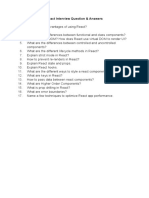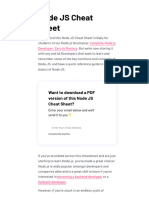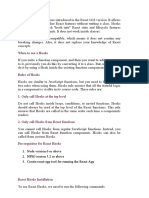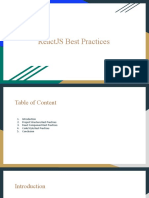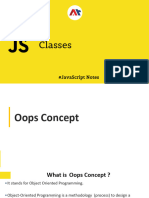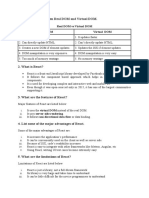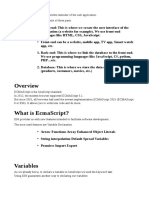0 ratings0% found this document useful (0 votes)
144 viewsReactJs Interview Questions
Uploaded by
Sohaib AmirCopyright
© © All Rights Reserved
Available Formats
Download as PDF or read online on Scribd
0 ratings0% found this document useful (0 votes)
144 viewsReactJs Interview Questions
Uploaded by
Sohaib AmirCopyright
© © All Rights Reserved
Available Formats
Download as PDF or read online on Scribd
You are on page 1/ 11
=
ReactJS
Interview
Questions You
Need to Know
With answers and examples.
Explain the Virtual DOM and
how it works in ReactJS.
The Virtual DOM in ReactJS is a lightweight copy
of the actual DOM that is used to improve
performance by minimizing the number of
updates to the actual DOM.
For example, when a user interacts with a React
component, the Virtual DOM updates first, and
then React compares the updated Virtual DOM
with the previous version to determine which
parts of the actual DOM need to be updated.
RAHUL PATIL
01
02
What is JSX and how is it
different from HTML?
JSX is a syntax extension for JavaScript that
allows developers to write HTML-like code within
their JavaScript files, and it is different from
HTML because it is not valid JavaScript code.
For example, in React, you can use JSX to define a
component's UI like this:
const element =
Hello, world!
; RAHUL PATIL 03 How does ReactJS handle state management? ReactJS handles state management by allowing developers to define and update state within a component using the useState hook, which triggers a re-render of the component when the state changes. For example, in a simple counter component, you can define and update the state like this: const [count, setCount] = useState(0); setCount(count + 1); RAHUL PATIL 04 What is the significance of props in ReactJS? In ReactJS, props are used to pass data from one component to another component down the component tree, and they are read-only Example: To pass data from a parent component to a child component, we can use props. We can pass the data as props when we are calling the child component, and then access the props in the child component RAHUL PATIL Explain the concept of React Hooks and how they are used React Hooks are a pattern that allows developers to use state and other React features in functional components, and they are JavaScript functions that manage state's behavior and side effects by isolating them from a component Example: The useState() hook allows us to create, track, and update a_ state in functional components 05 RAHUL PATIL What is the difference between controlled and uncontrolled components in ReactJS? In ReactJS, controlled components are components that have their state and behavior controlled by the parent component, while uncontrolled components manage their own state internally Example: A controlled component is bound to a value, and its changes will be handled in code by using event-based callbacks, while = an uncontrolled component is handled by the DOM itsel 06 RAHUL PATIL How does ReactJS handle server-side rendering? In ReactJS, server-side rendering renders the React components on the server and sends the output as HTML content to the client, which can be combined with client-side rendering to create an isomorphic app. Example: To implement server-side rendering ina React app, we can use a library like Next.js, which provides a framework for server-side rendering and other features like automatic code splitting and static exporting 07 RAHUL PATIL 08 What is the significance of the key prop in ReactJS? In ReactJS, the key prop is used to identify elements across renders, and it is most commonly used when rendering a list of items to help React identify which items have changed, are added, or are removed. Example: When rendering a list of items in React, we should assign a unique key to each item using the key prop to help React identify which items have changed, are added, or are removed RAHUL PATIL og Explain the concept of higher-order components in ReactJS. In ReactJS, a higher-order component is a function that takes a component and returns a new component, which is used to compose components for code reuse and logic abstraction. Example: We can use a higher-order component to add some functionality to a component, such as logging or authentication, by wrapping the component with the higher-order component RAHUL PATIL How does ReactJS handle performance optimization? In ReactJS, performance optimization can be achieved through code-splitting, which helps to “lazy-load" just the things that are currently needed by the user, and React lazy loading, which allows for the dynamic rendering of components. Example: We can use React.lazy() function to render a dynamic import as a normal component, which makes it simple to construct components that are loaded only when needed 10 RAHUL PATILYou might also like
- Most Asked Frontend Interview QuestionsNo ratings yetMost Asked Frontend Interview Questions23 pages
- Basic ReactJS interview questions and answersNo ratings yetBasic ReactJS interview questions and answers71 pages
- What's New in Angular 17 - Angular 17 - Yaay or Naay - by Thamodi Wickramasinghe - Feb, 2024 - Bits and PiecesNo ratings yetWhat's New in Angular 17 - Angular 17 - Yaay or Naay - by Thamodi Wickramasinghe - Feb, 2024 - Bits and Pieces17 pages
- Node JS Cheat Sheet + PDF Zero To MasteryNo ratings yetNode JS Cheat Sheet + PDF Zero To Mastery17 pages
- React Router Declarative Routing For React - JsNo ratings yetReact Router Declarative Routing For React - Js28 pages
- 32 Reactjs Interview Questions and Answers For 2019: Prepared by Devteam - SpaceNo ratings yet32 Reactjs Interview Questions and Answers For 2019: Prepared by Devteam - Space17 pages
- Essential Guide To Angular For All LevelsNo ratings yetEssential Guide To Angular For All Levels102 pages
- Differentiate Between Real DOM and Virtual DOMNo ratings yetDifferentiate Between Real DOM and Virtual DOM20 pages
- Summer Session, 2023 Beyond Seven Academic YearNo ratings yetSummer Session, 2023 Beyond Seven Academic Year1 page
- What's New in Angular 17 - Angular 17 - Yaay or Naay - by Thamodi Wickramasinghe - Feb, 2024 - Bits and PiecesWhat's New in Angular 17 - Angular 17 - Yaay or Naay - by Thamodi Wickramasinghe - Feb, 2024 - Bits and Pieces
- 32 Reactjs Interview Questions and Answers For 2019: Prepared by Devteam - Space32 Reactjs Interview Questions and Answers For 2019: Prepared by Devteam - Space










